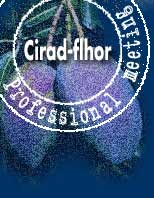

The importance of the storage of tropical fruits under modified
atmosphere: application to mango
Marie-Noëlle Ducamp-Collin, Cirad-flhor
Lengthening the life of mango is aimed in particular at improving the quality of exported fruits. Indeed, these are frequently picked too green, resulting in very poor quality and unsatisfactory ripeness. It is therefore important to harvest riper fruit, without risk of over-ripening during transport.
Conservation of fruits under modified atmosphere (MA) consists of creating an atmosphere different to that of the air (21% O2 and 0.03 % CO2). The carbon dioxide content is thus increased and oxygen decreased to slow the overall metabolism (both respiratory and biochemical) of the fruits. This atmosphere is created when a balance is established between fruit respiration (all fruits continue to live after harvesting and respiration continues) and the packaging.
A number of results of measurement of respiration performed according to mango varieties show that these respiration rates can differ by 100% (the case of comparison of Keitt and Kent). It is also noted that the respiratory quotient (RQ) differs considerably according to the variety. Complementary studies showed that this factor is related to the state of maturity of the fruit and not the variety itself.
Packaging enabling the creation of an MA can consist of a plastic film whose characteristics make it possible to determine the atmosphere or coating serving the same purpose but placed on the surface of the fruit directly in contact with the epiderm. The plastic film may vary in composition and have different permeability to gases. Favouring to a certain degree the passage of oxygen and carbon dioxide will cause a change in the atmosphere.
These modified atmosphere techniques have the following advantages:
- reduction of weight loss (drying and withering);
- slowing of maturation;
- reduction of the risk of chilling injury;
- conservation of quality (colour, moisture and flavour);
- the need for extra packaging equipment;
- a risk of problems if the film is poorly identified or if the temperature is not right;
- the possibility of unusual development of anaerobic flora;
- the problem of recycling plastic films.
Microperforated films
Tests have been performed with microperforated films with permeability ranged from 10,000 to 150,000 ml/m2 per 24 hours, with totally impermeable film (OPP) and very permeable film (Cryovac). The aim is to determine the best storage atmosphere for mango to obtain data applicable to selective films. It is observed that the storage of mangoes in strongly impermeable fill is fully able to conserve the outside of the fruit, with the colour being totally preserved. However, this total blockage of maturation is irreversible, whence the usefulness of the dosing of blockage using the appropriate films. It is noted that any permeability of less than 50,000 cannot be used with mango because it result in carbon dioxide accumulation causing fermentation.
Selective films
Trials on selective films must make it possible to incorporate the physiological parameters of the fruit, factors that may modify the latter (temperature, moisture, etc.) and the film parameters (thickness, composition and all the factors likely to modify permeability) to create the ideal atmosphere for lengthening fruit life. The parameters mentioned can be incorporated in a model enabling us to anticipate the results and above all to compare real experiments with modelling. We have worked on three mango varieties (Kent, Keitt and Tommy Atkins) using films of varying permeability (from 5,000 to 20,000 for oxygen and 10,000 to 20,000 for carbon dioxide). The different films used have made it possible to slow changes in fruits both in the external and internal colour and in the overall metabolism of mango. However, the blockage is totally irreversible if the film has not been well chosen. When permeability is well suited to mango (physiology, etc.), maturation can be retarded by 5 to 7 days in the Kent variety (at the sea transport stage) and by 6 to 12 days in the other varieties.
Coatings
We are working on the composition of wax type coatings to adjust the internal gas composition of fruits and which, placed on the surface, slow the metabolism. Different formulations have been developed and their effects on the respiration, biochemical composition and changes during storage have been studied. A shift in the climacteric of fruits has been observed, indicating a slowing of the evolution of coated mangoes but without the total blockage of ripening mechanisms. Such a blockage can be observed when coatings that are too impermeable are used; these halt the evolution of external fruit colouring, with the fruit remaining green for a very long time, and the organoleptic qualities subsequently required are not achieved. The colour can no longer change in this case. The best results are obtained with coatings based on carnauba wax to which polysaccharides are added. The quantity of polysaccharides in the final composition requires further adjustment to optimise these results.These trials have been carried out thanks to our partners in Mali-the CAE and the Fruitex company-who placed fruits at our disposal. Our trials are performed in collaboration with USDA Florida and are to continue during the coming West African season. We plan to conduct trials on other mango varieties from South Africa.
|
Centre de coopération internationale en
recherche agronomique pour le développement |